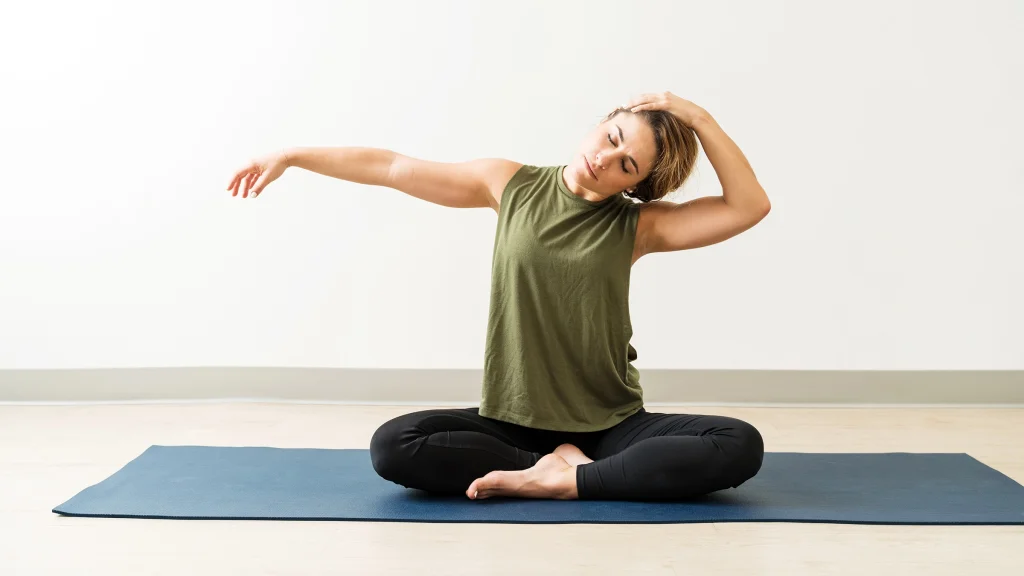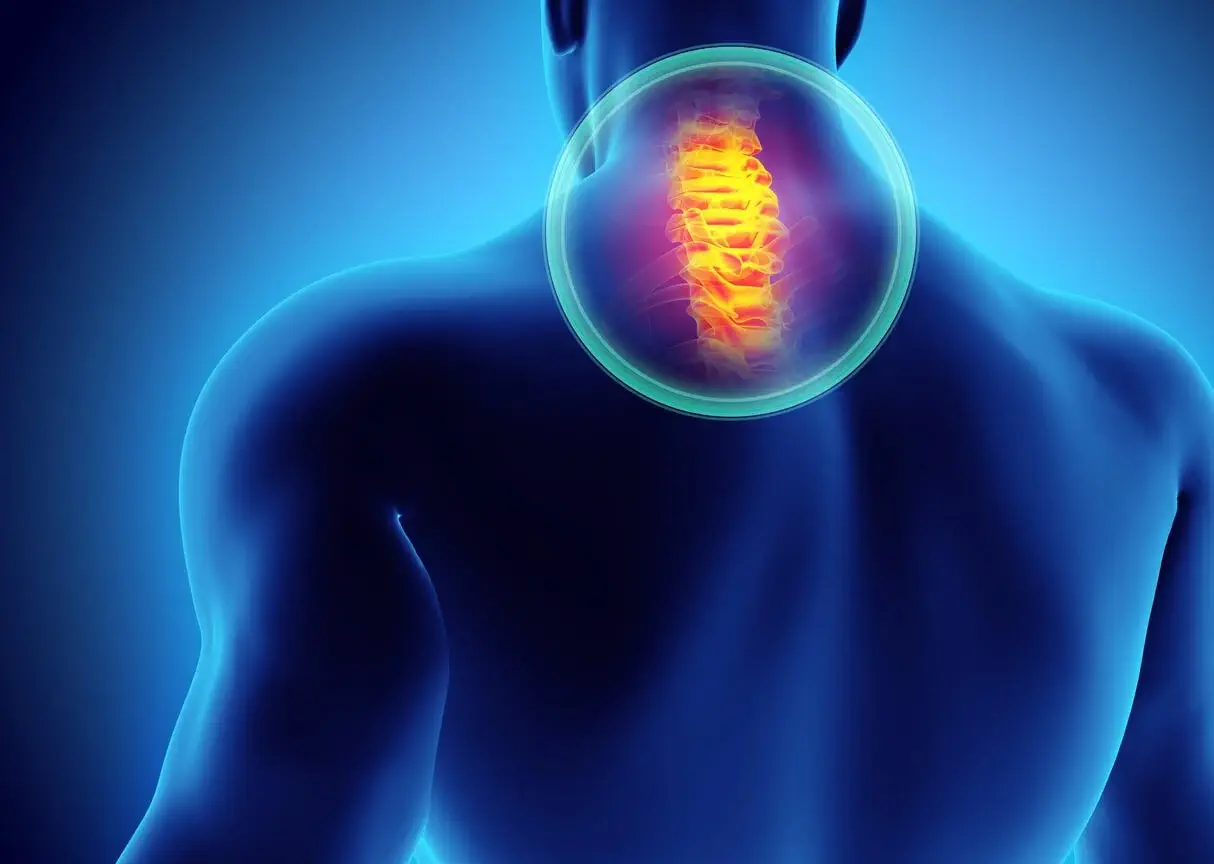
What are the Most Appropriate Exercises to Treat Cervical Disc?
Do you know what are the best exercises to treat cervical disc? Join us to learn about these exercises. You should know that the human body is built strong, flexible, and flawless, but a wrong lifestyle or lack of exercise can bring terrible disasters to your body. With constant bending over your phone, lifting heavy objects incorrectly, not taking care of your body, and not strengthening your joints, it is no wonder that many people experience neck pain at some point in their lives.
Cervical disc disease is more than just a pain in the neck and can have a huge impact on your job, family, and quality of life. What is the best exercise for neck discs? In this article from Human Health Mag, we want to address the topic of cervical disc and introduce methods for treating it with exercise and nutrition.
What is a Cervical Disc?
Before we get into exercises to treat cervical disc, it’s a good idea to first familiarize yourself with cervical discs. Cervical disc degeneration is a degenerative process that can cause severe pain as well as numbness and weakness in your shoulder, arm, and hand. The cervical spine in your neck is made up of seven bones called vertebrae that are separated by discs filled with a cushioning gel-like substance. Cervical discs both stabilize your neck and allow it to smoothly rotate from side to side and bend forward and backward.

Without these discs, the spine would be very stiff. Discs allow our bodies to move the way we want them to. They also provide cushioning for the body, acting as shock absorbers. Over time, the natural cushions between the vertebrae wear down and can begin to degenerate. The space between the vertebrae becomes narrow and the nerves are compressed. This process is known as cervical degenerative disc disease.
Research shows that about 25 percent of asymptomatic people under the age of 40 and 60 percent over the age of 40 have some degree of degenerative disc disease. As cervical disc disease progresses, the neck loses its flexibility and you may experience neck pain and stiffness, especially later in the day. Although cervical disc disease is a slow process, a herniated disc can sometimes occur quickly after an injury or blow to the neck.
Exercises for a Herniated Disc
In addition to medication and other pain management techniques, doctors may prescribe exercises to treat cervical disc. You can do these exercises with a physical therapist or at home with your doctor’s permission. Like exercise to treat lumbar disc, exercises for a herniated disc in the neck also include a combination of gentle stretches and muscle strengthening exercises. Neck stretches can help reduce pain and pressure in this area. Neck stretches usually involve slowly moving your head back, forward, or from side to side.
Exercises that strengthen the neck muscles are a more effective way to reduce pressure on the neck. These exercises may also help strengthen other muscles that support the spine, such as the abdominal muscles. Physical therapists can help you design an appropriate exercise and rehabilitation program. Exercises suitable for cervical disc include:
- Rotating the head left and right, forward and backward, and clockwise
- Stretching movements while sitting or standing
- Shoulder movements up and back and forth
- Easy walking, swimming, and cycling

Best Exercises to Treat Cervical Disc
Now we will teach you some exercises to treat cervical disc. Remember that if your doctor has prescribed specific exercises for you, continue with them and do not add any exercises to your program without his permission. Another thing is, if you feel pain or discomfort while doing these exercises, stop your exercise immediately.
Chin tuck
This exercise activates and strengthens your deep cervical muscles (the muscles in the front of the neck). The method is as follows:
- Place your finger under your chin;
- Slowly pull your chin back and tilt your head back. At the same time, use your fingers to keep your chin tucked the entire time;
- Maintain this position for 3 to 5 seconds;
- Relax your neck for a moment and let your neck come forward;
- Do this exercise in 2 to 3 sets of 10 repetitions.
Towel Neck Stretch
This stretch can relieve some of the pain and help the disc material return to its original position. If the stretch causes more pain, stop. Here’s how to do it:
- Sit in a chair with a towel around your neck;
- Now, pull your spine up and into the back of your chair;
- Slowly pull your neck back, holding the towel, being careful not to let your neck go too far back;
- Hold it for a few seconds, then return to the starting position;
- Do this exercise 5 to 10 times.
Single-Arm Stretch
This exercise stretches your chest muscles. These muscles may be tight and tight, affecting your neck position. Doing this will help you get better posture and relieve your pain. To do this:
- Stand close to a wall and place one of your hands on the wall with your palm facing up;
- Keep your back straight and don’t arch it at all;
- Now lean forward and slightly away from the arm;
- You should now feel a stretch in your chest area;
- Hold this position for 30 seconds and then do the movement for the other arm.
- The important thing about this exercise is to stretch not only your shoulder, but also your chest. If you do not feel a stretch in your chest muscles, change your angle and position.
Trapezius muscle stretch
This exercise stretches the muscles of the neck and upper back, which are probably very tight and tight in people with cervical disc herniations. To do this exercise, you should do the following:
- Start standing or sitting;
- Place one of your hands on the opposite side of your head and the other behind your head;
- Now pull your head down towards your shoulder (be careful to do this very slowly and gently);
- Use your upper hand to guide your head down for a deeper stretch; (This should be done without straining.)
- Hold this position for 20-30 seconds, then repeat on the other side.
Scapular Stretch Using a Band
This exercise is designed to stabilize and strengthen the muscles in your mid-back, allowing you to improve your posture. Repeat this exercise for two sets of 10, gradually increasing to three sets of 10. To do this:
- Stand in a comfortable, upright position
- Hold a resistance band (the level of resistance you use depends on your individual strength level) in both hands, straighten your elbows, and stand in line with the form
- With your elbows locked, slowly move your arms out and behind your body. You should feel the muscles between your shoulder blades contracting and tightening
- Continue as long as you are comfortable. Some muscle discomfort (burning) is okay, but you should not feel pain in your arms or neck
- Avoid raising your shoulders towards your ears.

Exercises to Avoid for Cervical Discs
Regular exercise can minimize the risk of developing a herniated disc, but there are some exercises to avoid. Exercises that force the neck to bend or cause spinal misalignment, putting too much pressure on the spine. Exercises that you should avoid or only do with your doctor’s permission include:
- Leg presses
- Squats
- Deadlifts
- Leg raises
- Standing leg raises
- Biking and rowing
- High-intensity jumping and movement exercises such as HIIT
- Any exercise that puts pressure or pain on the neck
Who Can do Cervical Disc Exercises?
People with the following conditions can do exercises to treat cervical disc:
- Pain, weakness or limited movement due to cervical disc
- People who are at risk of developing cervical disc disease due to their job, physical condition or age.
- People who do not have any problems in the neck area but are looking to prevent and strengthen this area.
Who Should not do Exercises for Cervical Disc?
The following people should not do exercises to treat cervical disc without consulting a doctor:
- Acute medical problems in the neck
- People who are in the acute phase of neck pain and inflammation
- Cervical instability
- People with a history of neck surgery
- A history of certain injuries or diseases in the neck
Concluding Remarks
In this article, we have taught some exercises to treat cervical disc. In general, neck pain or cervical disc pain is often caused by bad habits in walking, sitting, lifting objects, etc. Fortunately, this problem can be solved in most cases by changing lifestyle and correcting behavioral habits and doing certain exercises.
Appropriate exercise and exercises under the supervision of a physiotherapist significantly help improve a person’s symptoms and function by increasing the strength and flexibility of the neck and shoulder muscles, improving blood flow and disc nutrition, reducing pressure on the disc, reducing inflammation and pain, and improving nerve function. However, for exercise for cervical disc to be more effective, it must be done properly and professionally and under the supervision of an orthopedic specialist or physiotherapist so that they can have the greatest benefits for the patient.
We’re curious to hear your thoughts! What’s your take on this topic? Comment below and join the conversation; your opinion could spark new ideas!

Frequently Asked Questions
Does Exercise Reduce Cervical Disc Pain?
Yes, exercise reduces cervical disc pain, increases range of motion, and improves neck muscle strength.
Which Exercise is Best for Cervical Disc?
Yoga, Pilates, and stretching exercises are suitable for cervical disc.
Is it Possible to Definitively Treat Cervical Disc With Exercise?
No, definitively treat cervical disc with exercise is not possible, because the disease worsens over time.
Is Bodybuilding Harmful to Cervical Disc?
Lifting heavy weights and intense bodybuilding exercises are harmful to cervical disc, because they put a lot of pressure on the neck and spine.
Is Exercise Harmful to Cervical Disc?
No, not only is exercise not harmful to cervical disc, but it also increases range of motion and improves neck muscle strength.
